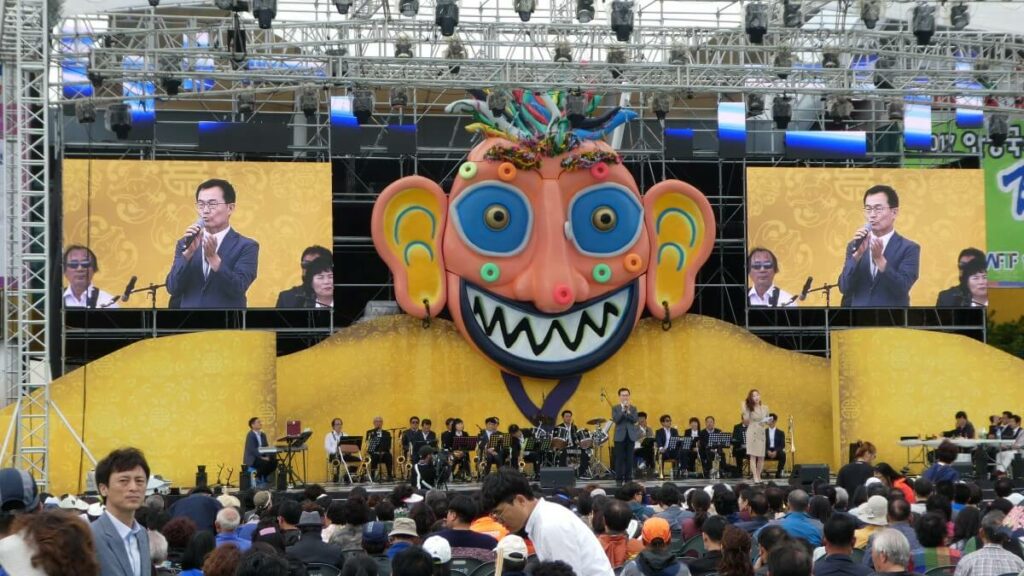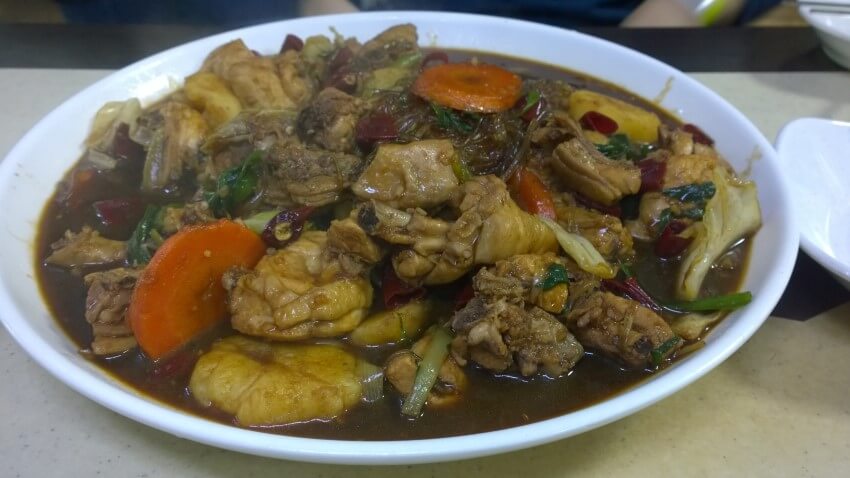While traveling through South Korea, a visit to Andong (안동,安東) is definitely not to be missed. This city on the Nakdong River is in fact the cultural heart of the country. Here you will find a number of traditional Korean villages, you can visit the largest mask festival in the world, and in the vicinity of Andong are a few Confucius schools that have played an important role in the history of South Korea.
And finally, you will find temples that are on the Unesco World Heritage List and you can enjoy one of the best alcoholic refreshments in the country. In short, enough reasons to visit Andong. Wondering how your stay in this cultural city will look like? Please read on and discover it in this historical travel guide of Andong.
This Travel Guide to Andong contains affiliate links. This means that if you make a booking through one of the links on this website, Travel4history gets a small compensation for it. This does not cost you anything extra by the way!
In this Travel Guide to Andong
This page about Andong contains affiliate links. This means that if you make a booking through one of the links on this website, Travel4history receives a small compensation. This is at no extra cost to you!

A brief history of Andong
Andong is a city of 150,000 inhabitants in Gyeongsangbuk-do Province. It has a rich history that began around the year 0. Back then, a settlement named Gochang existed here. In 918, the year the Goryeo Dynasty began (918-1392), it was named Andong. Okay, that name changed another 25 times, until Andong was officially named that way in 1963.
An important event in the city’s history is that it became the religious center of Korea around 1570. From China, the scholar Yi Whang (1501-1570) brought Confucianism to Andong, which led to the construction of a number of renowned schools following the teachings of Confucius.
During the Korean War of 1950-1953, heavy fighting took place around the city between the North and South Korean armies. As a result, both countries suffered great losses. This battle is among the heaviest and most intense that took place during the Korean War.
After the war, the city grew prosperously. It led to the construction of a dam in 1971, but the most important event really took place in 1999. That’s when Queen Elizabeth of Great Britain came to Hahoe Folk Village and planted a tree. And still today, this is among one of the most important topics of conversation among Koreans.

Sightseeing – 6 x to see and do in Andong
If you want to learn more about the art, culture, and history of traditional Korea then Andong is the perfect place to visit. But actually, the main attractions are mostly in the area and Andong will primarily be used as a base. Most tourists stay here for one day, but if you have time to spare, add another day. There is plenty to see. Below you will find 6 nice sights with a touch of history.
1. Discover Hahoe Folk Village, a traditional Korean village
Located 25 kilometers west of Andong is the lovely Hahoe Folk Village (안동하회마을). This is the busiest village in South Korea and is very popular among Korean and foreign tourists. It is beautifully situated among rice fields, hills, and the Nakdong River, and from one of the surrounding hills, you have a magnificent view of Hahoe Folk Village. So do you want to learn more about the traditional way of life of Koreans during the Joseon Dynasty (1392-1897)? Then definitely don’t skip this place!
Would you like to know more about this traditional village and its history? Then read more about it in the article Hahoe Folk Village, South Korea | Guide to a traditional Korean Village.

2. Visit the Andong Mask Dance Festival
the Andong Mask Dance Festival (안동국제탈춤페스티벌). This is the largest mask festival in the world and artists from all over the world perform here with music, dance and of course masks. The Andong Mask Dance Festival lasts for about 10 days and the venue is located within walking distance of the city center. There is also a market where you can buy food and drinks and play fun Korean games. But above all, it is very cozy and atmospheric.
Would you like to know more about this festival and the special legend it all started with? Read the article Andong Mask Dance Festival | The Lurid Masks of Hahoe.

3. Woryeonggyo Bridge, walk on the longest footbridge in Korea
4 kilometers east of downtown is the Andong Dam and the Woryeonggyo Bridge (월영교). Woryeonggyo or Moonlight Bridge is the longest footbridge in South Korea at 374 meters. Especially in the evening when it is dark, the bridge looks atmospheric and cozy with its many lights. A visit to Woryeonggyo Bridge can be combined with the Andong Folk Village. This village is similar to Hahoe Folk Village but has the advantage of being less crowded. The Woryeonggyo Bridge, the dam, and the Andong Folk Village are easily reached by bus, but an even better option is by bicycle.
4. Andong Soju Museum, the liquor of Korea
What saké is to Japan, soju is to South Korea. This liquor is brewed in Andong, among other places, and it is one of the better soju in the country. You can visit the Soju Museum (안동소주-전통음식 박물관) every day and it’s completely free. It takes you past an exhibition on the origins of this alcoholic refreshment and at the end, there is the opportunity to try a sip. But be warned: with an alcohol content of 45% it is quite strong…

5. Bongjeongsa Temple, a historic Korean temple
Bongjeongsa Temple (봉정사) was first built in 672 by the monk Ui Sang, although documents claim that a disciple of his would have founded it. It is one of the oldest temples in the area and consists mainly of wood. On the grounds, you can visit the Geungnakjeon, the oldest wooden building in South Korea. Historians claim that it was built in 1200.
The Bongjeongsa temple can be visited every day, but if you really want something out of the ordinary, spend the night there. You can find more information on the Templestay website (website in Korean). Admission to the complex costs 2000 won and from Andong Intercity Bus terminal it is about 30 minutes by bus.
6. Dosan Seowon, an influential private school of Confucius
The scholar Yi Hwang (1501-1570) was one of the most important philosophers of the Joseon Dynasty. At the end of his life, he founded the Yeongnam School and the academy Dosan Seowon, which became one of the most important in Korea only after his death. Confucianism was central and since 2019 this academy has been listed as a Unesco World Heritage Site. Want to visit this historic site and learn more about Yi Hwang and Confucianism? Dosan Seowon (도산서원) is located 30 kilometers north of the city and can be reached by bus 560 or 567.

Accommodation – Where to stay in Andong?
Staying in the city of Andong is a great base for exploring the surrounding area. I stayed at Peter Pan Guesthouse. This is one of the few hostels you can find in town but is run by a helpful owner. For a bed, in a dorm, you pay about 13 euros and the beds are fine. I was in Andong during the Mask Dance Festival at the beginning of October and booked a bed at the hostel about 2 days in advance. It just goes to show that there was still room in this guesthouse.
Another place to stay is at the Hahoe Folk Village. Several residents rent out a room and it is the ultimate chance to escape the busy city and relax in a beautiful and peaceful setting. Finally, of course, you can also spend the night in a temple, such as the Bongjeongsa.
Looking for accommodation in Andong? Check here the options
Food and drink: Andong has a number of local specialties, of which Jjimdak is definitely worth trying! This meal consists of stewed chicken with vegetables and noodles and is quite spicy. At Andong Gu Market, you can find a number of good restaurants that serve this. Other local drinks or dishes are of course Soju and salted mackerel.

Transport – How to get to Andong?
Andong does not have an airport but is easily reached from all directions by train or bus. The best way is by train, as Andong’s main train station is in the city center. From Seoul Cheongyangni there are 8 trains daily (5 hours) to Andong. Another way is by bus and that too is fine. The bus station is about 5 kilometers west of the center and every hour (or earlier) a bus leaves for important cities like Seoul and Busan. To book train tickets go to the Korail website.
Next Destination in South Korea?
To the north, go to the city of Gangneung and the beautiful Seoraksan National Park. To the north-west, head to the capital Seoul and to the south you’ll find Daegu, Gyeongju, and Busan.
Do you have more tips, comments, or ideas about this historical travel guide to Andong, South Korea? Feel free to leave a comment below!